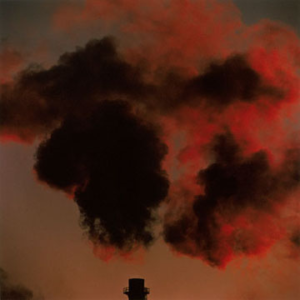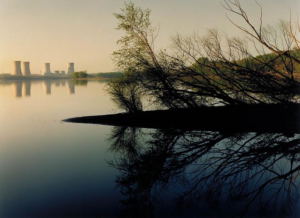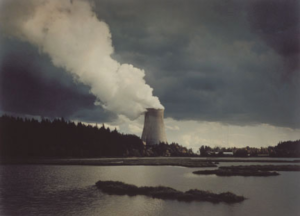Smoke, Mirrors, and Power
One of the problems any artist has when approaching any landscape with art in mind is that he or she is stalked by three hundred years of aesthetic convention. Since the mid-eighteenth century, the Enlightenment thinkers did what philosophers of that era did: they divided nature into categories, gifting architects, artists, and poets with concepts to work within. These categories, the sublime and the picturesque and subsequent the classical constructions of those scenic tropes have been dissected in previous posts and podcasts, and while the Enlightenment habits of thinking dialectically have long since been interrogated, the polarities of “landscape” have remained remarkably intact. It is an open question of whether the photographer John Pfahl (1939-) continues to activate these Burkean categories as historical forms that gesture towards the past to remind the viewers of the gulf between England on the edge of an Industrial Revolution and today’s world which is being engulfed by global warming. Pfhal could be in a state of mourning or he could be presenting warnings or he could simply be showing how eternal are the ways in which we view the world in which we live. In speaking of his work Power Places, he said, “It is not without trepidation that I have appropriated the codes of “the Sublime” and “the Picturesque” in my work. After all, serious photographers have spent most of this century trying to expunge such extravagances from their art. The tradition lives on, mostly in calendars and picture postcards. I was challenged to rework and revitalize that which had been so roundly denigrated. However, by making the landscape appear so romantic, would it promote the naïve impression that these power plants were living in blissful harmony with nature? Would my work be co-opted by industry? I needn’t have worried. For the most part, the work has been received in the same spirit as it was intended.”

John Pfahl. Occidental #18, Niagara Falls, N. Y. (1990)
The explanation that Pfahl has given so explicitly would seem to be quite adequate but the collection of Chromogenic prints have pleased and puzzled audiences who might expect explicit political statements from the artist. Over the three decades, since the Power Places (1980-84) collection was presented, Americans have gone from being hopeful of the promise of atomic energy to wary, especially after the accident at Three Mile Island, of atomic threats to the environment. Today some of the plants photographed by Pfahl are shuttered and decommissioned such as the Trojan Nuclear Plant in Oregon and the twin plants at San Onofre near San Diego. The demise of nuclear has been paralleled by the demise in coal, already obsolete in Lackawanna Valley decades before Pfahl began his study of power in America. Even though he was working after Three Mile Island, Pfahl took no particular stance. In her 1996 article, “Of Mother Nature and Marlboro Man: An Inquiry into the Cultural Meanings of Landscape Photography,” Deborah Bright wrote, “Every critic who has assessed John Pfahl’s widely published portfolio Power Places has expressed astonishment and some confusion about his apparent lack of political consciousness in making such lush, large-format, beautiful pictures of nuclear power plants. Even those who are quite at home with traditional art photographs seem a bit nonplussed when confronted with Pfahl’s serene impression of Three Mile Island, reflected in the still, quiet waters of the Susquehanna River early on a sunny morning..If setting up a ‘dissonance’ between the romantic pastoralism of the landscapes and the potentially dangerous power plants within them was Pfahl’s intended strategy, it is not carried through consistently, for he photographs nonhazardous power places such as hydroelectric facilities and dams with identical concerns for beauty and formal concern. One suspects other motives at work here, namely marketing strategies in the art collecting world.” Bright concluded her thought by stating that the “theme portfolio” combined “conventionally beautiful photographs of socially-loaded subjects with a fashionably ambiguous high-tech/political/ecological theme” that was “highly marketable without offending any potential buyer–a corporate client in the energy industry, for example.”

John Pfahl. Three Mile Island Nuclear Plant, Susquehanna River, Pennsylvania (1982)
However, if one pays attention to what John Pfahl was actually photographing, it would be difficult to suggest that he was in any way appeasing the industries that produced power. As was stated previously, that several of the nuclear “power places” photographed by the artist have been closed due to public pressure and faulty operation that put the environment at risk. Next year, the infamous Three Mile Island facility will close. In a brief article, “Three Mile Island Nuclear Power Plant To Shut Down In 2019,” Merrit Kennedy recalled the ill-fated accident, “On March 28, 1979, the core of one of Three Mile Island’s nuclear reactors partially melted down..The meltdown put the brakes on building new nuclear plants in the U.S., and prompted the industry to apply more stringent safety standards.” The author noted that, faced with solar alternatives and natural gas, that although “nuclear reactors don’t release carbon emissions. Opponents of the subsidies say nuclear energy is risky and more expensive than alternative forms of power.” A year after the “meltdown,” John Pfahl began his Power Places series. While he was working on this series, the citizens of Portland, Oregon were actively protesting a power plant in their neighborhood. An unauthored paragraph on a Land Use Database noted in passing that “The plant went on line in 1976, and was said to have been built on an Indian burial ground. When it shut down 16 years later, it was the largest commercial reactor to be decommissioned.” Without suggesting that the land was sacred or that the plant might have been ill-fated from the beginning, it is possible to read of the amazing end of this site as if a cursed object were being disposed of. “The only nuclear power plant in Oregon shut down twenty years early, after a cracked steam tube released radioactive gas into the plant in 1992..In 2001, the 1,000-ton 1,130-megawatt reactor was encased in concrete foam, and coated in blue shrink-wrapped plastic, then shipped up the Columbia River on a barge to the Hanford Nuclear Site in Washington, where it was placed in a 45 foot deep pit, and covered with six inches of gravel, making it the first commercial reactor to be moved and buried whole.”

John Pfahl. Trojan Nuclear Plant, Columbia River, Oregon (October 1982)
Twenty years later, it is possible to put forward the possibility that, when considered in their context, even as it shifts, the photographs are quite capable of speaking for themselves. The work of the post-sixties generation of photographers who re-examined the traditions of American landscape photography and American landscape painting fell into all the available categories of successive decades, from re-photography to conceptual art to postmodernity. Within this context, it seems old-fashioned to limit the meaning of the images to the artist’s intention. Indeed, the fact that the Power Places is of interest today, as we enter into an age of wind and solar power surely attests to the ability of the images to provoke thought. However, without staking out a theoretical position on artistic activism, the spectator understands that, regardless of the time or place of viewing, the photographs are updates of eighteenth-century landscape painting, speaking of technology through the camera as a machine in itself. Whether Pfahl is posting the sublime or the classical, the formal language of how landscapes can be organized remains unchanged, borrowing serenity from Claude and quoting the non-centered horizons floating high or low from the Dutch and recalling the bright middle ground of English scenes and referencing Bierstadt’s American bright skies. Was the photographer lamenting the lack of new visual vocabulary in a time of impending apocalypse was he using the distance he established in his photographs as an emotional space where irony can enter?

John Pfahl. San Onofre Nuclear Generating Station, San Clemente, California (June 1981)
Interestingly enough, Pfahl followed up on Power Places with another take on the industrial production of power in what can be considered the pendant to the early suite, Smoke (1988-1989). Smoke, a long study of great billowing clouds of pollution spewing from the open mouths of factory chimneys is the sublime counterpoint to the classical calm of Power Places. In 1990, Andy Grundberg wrote an article, “Beauty and Challenge In Modern Landscapes,” that was a review of ”The New American Pastoral: Landscape Photography in the Age of Questioning,” at the Whitney Museum, organized by Robert Sobieszek, who was on his way to the Los Angeles Country Museum of Art. Grundberg opened his observations with this paragraph: “One of the tasks of the art of the last 10 years has been to reconstruct the notion of natural beauty in the face of a seemingly endless onslaught against nature. Mankind’s alteration of previously pristine spaces, from tropical rain forests to the very air we breathe, poses a challenge that is not only environmental but also esthetic: can art reflect what is happening to the natural world while retaining its traditional attachment to the sublime?”

John Pfahl. Bethlehem #22, Lackawanna, N.Y. (1988)
The art critic made an interesting observation on John Pfahl stating, “John Pfahl’s are perhaps the most ambiguous and most engagingly complex pictures in the show. He has photographed nuclear power plants in warm, lambent light, giving them the look of transcendental, Hudson River School paintings. And in the series ‘Smoke’ he has pictured industrial smokestack emissions as if they were glorious clouds seen by the camera of the naturalist Eliot Porter or recorded by the brush of John Constable.” Grundberg referred to “Mr. Pfahl’s simultaneous evocation and debunking of the picturesque tradition” but his series on Smoke would seem more appropriate to the Romantic tradition of the sublime. These photographs are linked to the Power Places series but they are also the successors to the painting by George Inness, The Lackawanna Valley (1857). On one hand, the smokestacks and billowing clouds of smoke captured mid-formation are close-ups of the production of power and on the other hand, because they are located in the Lackawanna Valley, these smokestacks are the successors to the puffing locomotive depicted by Inness. In a brief article on Bethlehem Steel, Mark Sommer wrote in 2016 that “The Lackawanna steel plant made iron and steel for 82 years, 60 of those under the banner of Bethlehem Steel. The steel mill provided good-paying jobs for high school graduates and dropouts alike. Employment peaked in 1965 at 20,000, with the company paying more than 75 percent of the taxes in Lackawanna, and a significant amount in nearby Hamburg, where the company also had operations. Production peaked in 1973, but the company eventually concluded the plant was obsolescent, and it didn’t want to spend the money to meet state and federal air and water pollution regulations. At the same time, profits fell as foreign competition increased. That led the company to move most of its operations to Burns Harbor, Ind., in 1983, devastating the community it left behind..The Bethlehem Steel plant was named a Superfund site by the Environmental Protection Agency in 1988. The state later declared it an inactive hazardous waste site, indicating a potentially significant threat to human health and the environment existed.” Two years later John Pfahl was in the Valley photographing the last of the steel industry.

John Pfahl. Bethlehem #16, Lackawanna, N. Y. (1988)
This site is now being restored. In a 2017 article, “New Life for Former Bethlehem Steel Site?” Justin Moore wrote, “The Erie County Industrial Development Agency is transforming the land into a clean energy business park. The land was officially purchased from the former owners Tecumseh Redevelopment Tuesday morning. The first step of the project calls for building this 80,000 square foot facility that will be powered by solar energy.” The article concluded with a eulogy for the long-vanished steel industry: “Lackawanna steel mill industry once provided thousands of jobs to people for decades. The site has become a relic of the past after manufactures started leaving in the early 1980s.” In reconsidering Power Places and Smoke, it is important to recognize the historical context of these two series. Pfahl was positioned–accidentally or on purpose–at the end of two sources of power, once considered so promising. Even as early as 1980, nuclear energy was being questioned and the steel industry was in its death throes. Both of these bodies of photographic works could be considered as both critiques and as elegies to dying hopes. Today the Lackawanna Valley is healing itself from a century of pollution and in the summer of 2018, the former site of Bethlehem Steel has become an industrial park, complete with a bike path, celebrated by the mayor, Geoffrey Szymanski who said, “The old Bethlehem Steel site, which for so many of us became a symbol of Lackawanna’s lost glory days, is passing into history. Rusty remnants of that past are being replaced and remaking this site into an attractive, business-friendly park that is also a recreational connector between the City of Buffalo and, eventually, Woodlawn Beach. This is the most exciting and vital improvement to happen here at Bethlehem in my lifetime and will be a game-changer for the people of the City and all of Erie County.”
Another aspect of interpreting the photographic series of John Pfahl would be another question: what did he not photograph? We see little that is pastoral and bucolic or simply beautiful to bring forward another category of Enlightenment landscape concepts in the oeuvre of this photographer. Like Ansel Adams of an earlier time, Pfahl could have made a mirror image of his Power Places by finding pristine and untouched landscapes and he could have presented a reassuring or nostalgic vision of nature preserved. The Romantic tradition allowed for the picturesque paintings of John Constable and the disturbing explosions of sublime color by Joseph Turner and for the elegiac magic of Caspar David Friedrich. But this photographer holds up a mirror to the viewer and presents him or her with the contemporary consequences of civilization in the late twentieth century. Hundreds of years after Thomas Jefferson imagined America as being the pastoral future of Arcadia, we are still tormented by the same dilemmas: how to survive as humans and how to preserve the land. Pfahl’s photographs seem to suggest that we are no closer to an answer.